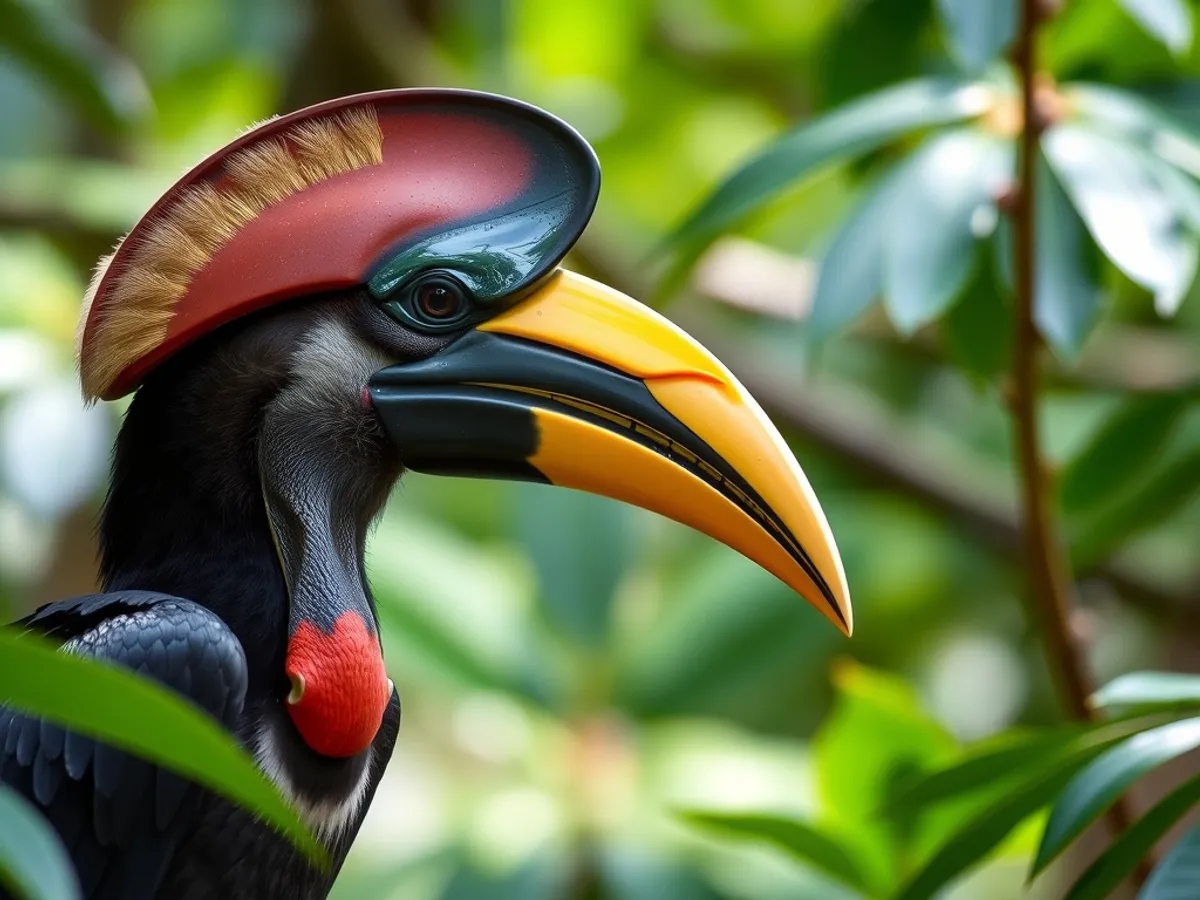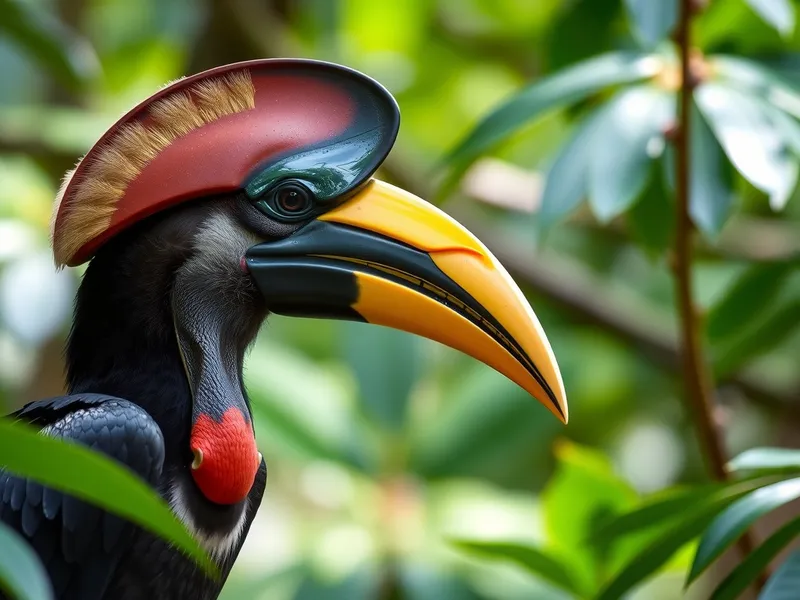
Helmeted Hornbill
Rhinoplax vigil

Meet the Helmeted Hornbill
The Helmeted Hornbill is a striking and large bird native to the forests of Southeast Asia. Distinguished by its unique solid casque, or helmet, on top of its bill, this hornbill uses its prominent structure in aerial jousting contests with other males. Its impressive size, long central tail feathers, and loud, resonant calls make it a memorable sight and sound in its rainforest habitat. Sadly, this species faces severe threats from hunting for its casque, which is highly valued in illegal trade, and from habitat loss, making it one of the most endangered hornbills in the world.
Classification
Bird
Habitat
Tropical lowland and evergreen forests
Diet
Omnivore
Lifespan
35-40 years
Conservation
Critically Endangered
Weight
2.5-3.1 kg
📖Fascinating Facts
Unique Casque
Unlike most hornbills, the Helmeted Hornbill has a solid, ivory-like casque that is used in combat and is highly sought after in the illegal wildlife trade.
Forest Dweller
This species relies on large tracts of primary rainforest, making it particularly vulnerable to deforestation and habitat fragmentation.
Loud Calls
The Helmeted Hornbill’s call consists of a series of strange, laughter-like sounds that echo through the forest and can last for up to six minutes.
📋Detailed Description
The Helmeted Hornbill (Rhinoplax vigil) is among the largest hornbill species, measuring 110–120 cm in length, with males typically weighing between 2.7 and 3.1 kg. Its most distinctive feature is the massive, solid casque atop its bill, which accounts for approximately 10–11% of its total body weight and is unique among hornbills for being almost entirely solid keratin. The casque extends from the base of the bill to the crown and is used in dramatic aerial jousting contests between males. The bird's plumage is mostly blackish with a white belly and tail, and the central tail feathers are greatly elongated, sometimes exceeding 50 cm. The bare skin of the throat is bright red in males and pale blue in females, serving as a visual cue in social interactions. Helmeted Hornbills are highly vocal, producing a series of far-carrying, resonant hoots followed by a maniacal laughter-like cackle, which can be heard over a kilometer away. Their powerful wings produce a distinctive whooshing sound in flight. This species is primarily arboreal, rarely descending to the ground, and is an important seed disperser in its lowland forest ecosystem. Its large size, unique casque, and striking calls make it a flagship species for Southeast Asian rainforest conservation.
💡 Did you know?
The casque of the Helmeted Hornbill is made of solid keratin and is so prized in some cultures that it is often referred to as 'hornbill ivory,' making the species a target for poaching.
🔬Research & Sources
Wikipedia Summary
The helmeted hornbill is a very large bird in the hornbill family. It is found on the Malay Peninsula, Sumatra, Borneo, Thailand and Myanmar. The casque accounts for some 11% of its 3 kg weight. Unlike any other hornbill, the casque is almost solid, and is used in head-to-head combat among males. It is a belief among the Punan Bah that a large helmeted hornbill guards the river between life and death.
Last Modified: 5/27/2025
🎭Behavior & Social Structure
Helmeted Hornbills are diurnal and spend most of their time in the upper canopy of primary lowland and hill forests. They are generally solitary or found in pairs, though small family groups may occur. Males are highly territorial and engage in spectacular aerial head-to-head combat, ramming their casques together mid-flight, often accompanied by loud calls. Their diet is primarily frugivorous, with a strong preference for figs (Ficus spp.), but they also consume small animals such as insects, reptiles, and occasionally small mammals. Feeding typically involves plucking fruit while perched or making short flights between fruiting trees. Helmeted Hornbills play a crucial ecological role as seed dispersers, particularly for large-seeded trees. They are known for their deliberate, methodical movements and spend long periods quietly foraging or resting in the canopy.
👶Reproduction & Life Cycle
Breeding occurs during the dry season, from February to May, though timing may vary regionally. Helmeted Hornbills exhibit a unique nesting behavior: the female seals herself inside a natural tree cavity using a wall of mud, fruit pulp, and feces, leaving only a narrow slit through which the male passes food. The clutch size is typically one or two eggs, with the female incubating for about 38–40 days. During this time, and throughout the early chick-rearing period, the male is solely responsible for providing food. After hatching, the chick remains in the nest for up to 100 days, after which the female breaks out and both parents continue feeding the fledgling until it is independent. This intense parental investment and reliance on large, old trees for nesting make the species especially vulnerable to habitat loss.
🛡️Adaptations & Survival
The Helmeted Hornbill's solid casque is a remarkable evolutionary adaptation, serving both as a weapon in male-male combat and as a resonant chamber to amplify calls. Their strong, curved bill and powerful neck muscles enable them to forage for large fruits and engage in casque-butting contests. The elongated central tail feathers may play a role in sexual selection or species recognition. Their zygodactyl feet (two toes forward, two backward) provide a strong grip for perching in the high canopy. The female's ability to seal herself in the nest cavity provides protection from many predators during the vulnerable incubation and chick-rearing stages. Their loud, far-carrying calls facilitate communication across dense forest landscapes.
🎨Cultural Significance
The Helmeted Hornbill holds significant cultural value among indigenous peoples of Borneo, such as the Punan Bah, who believe a giant hornbill guards the river between life and death. Its casque has historically been carved into ornaments, jewelry, and ceremonial objects, particularly in China and Japan, where it is considered a luxury material. The bird features in local folklore and is sometimes seen as a symbol of the forest's spirit or as an omen. Conservationists have used its charismatic image to raise awareness about the plight of Southeast Asian rainforests and the illegal wildlife trade.
🔬Recent Research & Discoveries
Recent research has focused on mapping the extent of illegal trade in hornbill ivory, population genetics, and the ecological role of the Helmeted Hornbill as a keystone seed disperser. Acoustic monitoring is being used to estimate population densities in remote forests. Studies have highlighted the importance of large, contiguous tracts of primary forest for the species' survival. Ongoing research is investigating the effectiveness of community-based patrols and law enforcement in reducing poaching. There is also interest in the evolutionary development of the solid casque and its role in sexual selection and species recognition.
🎥Wildlife Videos

Inside the Mission to Save the Rare Helmeted Hornbill From Poachers | National Geographic
What does it take to photograph the helmeted hornbill? Patience. National Geographic photographer Tim Laman teamed up with ...
National Geographic

Devoted hornbill couple turn nest into fortress 🌳 | Planet Earth III - BBC
If this isn't devotion, we don't know what is... While this hornbill dutifully takes care of her eggs, her devoted partner delivers all of ...
BBC

20+ Hornbill Birds You Won’t Believe Nest Like This | Wildlife Documentary | BBTV Official
These Birds Seal Themselves Inside Trees to Become Mothers | Most Remarkable Hornbills on Earth Soaring above ancient ...
BBTV Official

Hunting The Helmeted Hornbill
The Helmeted Hornbill Is a Living Treasure—and That's a Problem. Over the last decade, Helmeted Hornbills have experienced a ...
Cornell Lab of Ornithology

Hornbills Are Too Weird To Be Real
----------- SOCIAL MEDIA https://www.tiktok.com/@animalogic https://www.instagram.com/animalogicshow/ ...
Animalogic

video great hornbill & extinct animal protection helmeted hornbill
video great hornbill & extinct animal protection helmeted hornbill Endangerd animals list _ Care and protection of rare animals _ ...
Nannie Eisse
🌍Habitat Information
The Helmeted Hornbill typically inhabits Tropical lowland and evergreen forests environments. Helmeted Hornbills have adapted to their environments with specialized features and behaviors.
Primary Habitat:
Tropical lowland and evergreen forests
More detailed habitat information will be available soon.
🛡️Conservation Status
The Helmeted Hornbill is currently classified as Critically Endangered. Conservation efforts are crucial for preserving this species for future generations.
Common Threats:
- 🏠Habitat loss and fragmentation
- 🌡️Climate change impacts
- 🎯Hunting and poaching
- 🏭Human-wildlife conflict
⚠️Threats & Conservation Challenges
Helmeted Hornbills face severe threats from illegal hunting for their solid casque, known as 'hornbill ivory,' which is highly prized in the illegal wildlife trade, particularly in China and other parts of Asia. This trade has escalated dramatically since the 2010s, leading to catastrophic population declines. Habitat loss due to logging, conversion of forests to agriculture (especially oil palm plantations), and infrastructure development further exacerbates their decline by reducing available nesting sites and food resources. Their specialized nesting requirements and low reproductive rate make population recovery slow. The species is classified as Critically Endangered by the IUCN, with estimates suggesting a decline of over 80% in the past three generations. Conservation efforts are hampered by the remoteness of their habitat, lack of enforcement, and ongoing demand for hornbill ivory.
🔬Scientific Classification
Scientific Name
Rhinoplax vigil
Classification Hierarchy
🔍 About Taxonomic Classification
Taxonomic classification is a hierarchical system used by scientists to classify and organize living organisms based on shared characteristics and evolutionary relationships.
The system moves from broad categories (Kingdom) to increasingly specific ones, with each animal's scientific name typically consisting of its Genus and species.
📝Community Notes
Share your observations and insights about the Helmeted Hornbill with our community of wildlife enthusiasts.
Join Our Community
Sign in to share your observations and connect with fellow wildlife enthusiasts.
Sign In to ContributeNo community notes yet
Be the first to share your observations about the Helmeted Hornbill!
Explore Helmeted Hornbill
Select a tab above to learn more about this amazing animal.
📸Photo Gallery
No photos available for this animal yet.
🌟Discover More Wildlife
Continue your journey of discovery with more fascinating animals from our database
